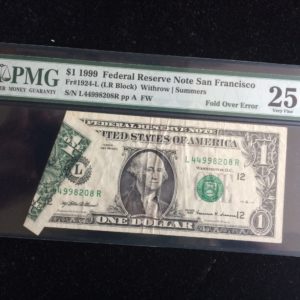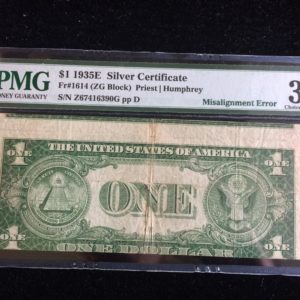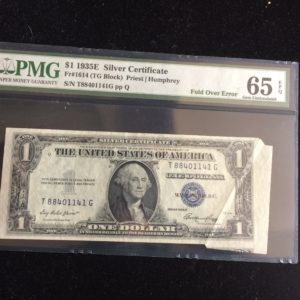United States Error Notes
Printing Errors on US Currency
Housed within the Department of the Treasury, the Bureau of Engraving and Printing (BEP) is responsible for developing and producing US currency notes.
Bank notes in the US are composed of 75% cotton and 25% linen. This gives them that distinctive currency note feel, and makes the note far more durable than paper.
In the production process, bank notes are printed three times in sheets of 32 notes. The back is printed first – after drying, the front is printed and dried again. The final printing adds the serial numbers, Treasury seal, and Treasury number in an overprint process onto the front of the note.
Occasionally, printing errors on bank notes by the BEP are released to the public. These errors have become an exciting and popular category of bank note collecting.
Increasing Value
The BEP uses state-of-the-art technology to prevent the production and dissemination of erroneous bank notes. They constantly update their systems and methodology to reduce the amount of printing errors that make it into circulation.
The BEP currently uses the Upgraded Offline Currency Inspection System (UOCIS) to examine uncut sheets of 32 notes prior to the overprinting stage. The UOCIS integrates computers, cameras, and sophisticated software to analyze these sheets at a rate of 8,000 per hour. Any sheets that fail to pass the “golden image” test, which compares the actual notes to a pre-established standard, are immediately removed and scheduled for destruction.
After a sheet of notes passes through the UOCIS inspection process, they are cut into 16-subject sheets and passes through the Currency Overprinting Processing Equipment (COPE). In this press, the notes receive their final print before undergoing a COPE Vision Inspection System. This system is now inspecting 100% of the finished work. Previously 6% of the finished work was being inspected. Each sheet is individually examined to ensure that the overprint was applied correctly – including serial numbers, prefixes, suffixes, and bank numbers. The entire inspection process for a sheet takes only 200 milliseconds as the system sorts out and removes any defective notes.
In 2014, the BEP oversaw the introduction of larger sheets containing 50 notes. Used exclusively for the $1 bill product line, the BEP required newer, more sophisticated equipment capable of handling the super-sized sheets. Enter the Large Examining Printing Equipment (LEPE), machines specifically designed to examine and prepare printed sheets for circulation. These systems use 20 cameras in multiple inspections and verification steps at a staggering rate of 9,000 sheets per hour.
As a result of these advancements in the process of currency inspection, the amount of printed errors entering circulation has significantly decreased. With the BEP catching more and more errors before they can be released, the value of the existing flawed bank notes has risen exponentially. Further improvements in screening technology will further reduce the availability of bank notes with printing errors, too.
Types of Printing Errors
While there are many different types of printing errors, below is a list of some of the most sought after errors in collecting.
Inverted Back – sometimes called “upside-down notes,” this error occurs when the sheet of notes is rotated 180 degrees between the first and second printing.
Mismatched Serial Numbers – there are several different causes for this error, including a malfunctioning digit counter. The more digits that are mismatched, the more valuable the note. Notes with mismatched characters are especially rare.
Blank Back – also called a “blank reverse,” these errors are often the result of two sheets being fed into a press at the same.
Double or Multiple Impressions – these errors occur when a sheet is re-fed through the press after receiving printing, resulting in a blurred or fuzzy image.
Offset Printing – also called “offset transfer,” these errors often occur when an inked plate contacts the bed instead of a sheet. When the next sheet is fed into the press, it is pressed against the ink on the bed and effectively receives a double-printing in one step.
Cutting Errors – these are some of the most desirable of errors. After a sheet of 32 notes is printed, they are cut into individual bank notes. There is a wide variety of cutting errors, ranging from minor to extremely significant.
Obstruction Errors – when a stray piece of material physically gets between the sheet and the printing plate, the ink is applied to it instead of the note. As a result, a section of the finished note will appear blank.
Missing or Misplaced Prints – a wide variety of errors can occur at each interval in the three-step printing process. For example, the final overprint step alone can be misaligned, absent, printed on the back of the note, and/or inverted.
Gutter Fold – also called a “blank crease,” this error occurs when uncut sheets are sent through the press with a wrinkle in the paper. A note might have one wrinkle or multiple wrinkles. These errors are relatively common.
Printed Fold – this error occurs when an uncut sheet folds over and remains folded during the printing process.
Inking Errors – there are a lot of different kinds of inking errors, including smears passed from the press to the note. Unfortunately, these errors are easily counterfeited, and should be examined carefully.
Visit Us
81 Sunderland Road
Amherst, Massachusetts 01002
Call Us
(413) 695-4213
Email Us
matthewcorcoran27@gmail.com



